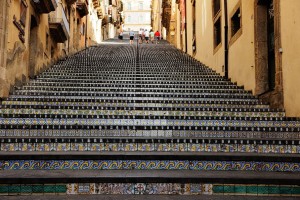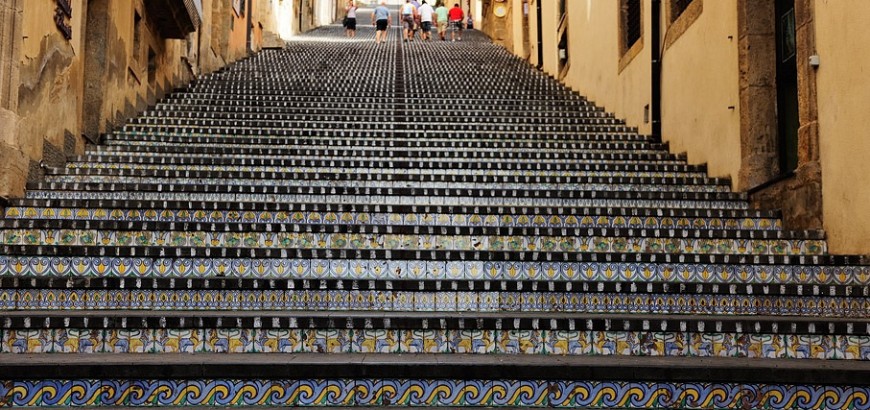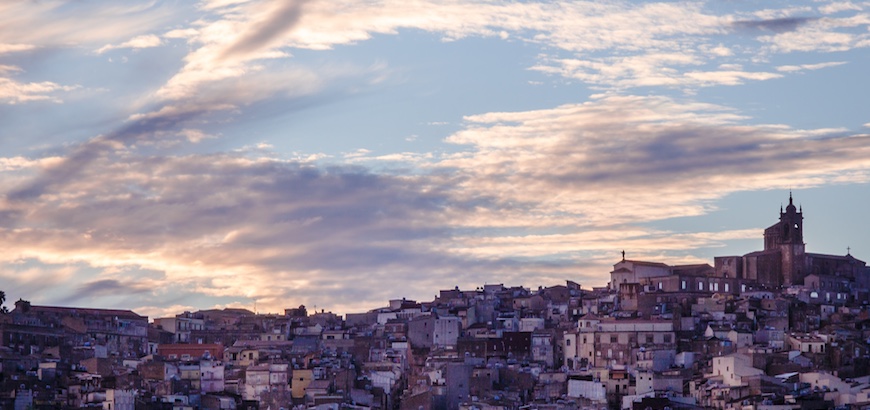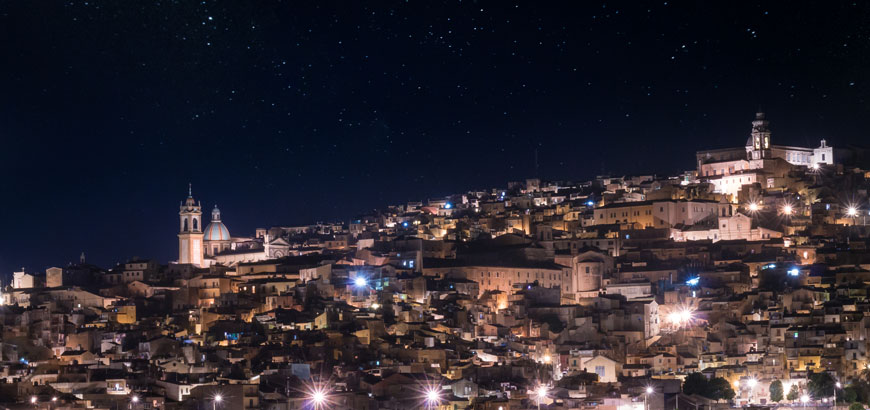
Caltagirone
Visit the shop of the local craftsmen, and discover the creativity of this beautiful city.
Caltagirone is one of the most important tourist destinations in Sicily thanks to its artistic and ceramic heritage and the beauty of its views and monuments. The main road of the town is the long via Roma which cuts the city in two and leads to the famous S. Maria del Monte stairway. The stairway forms the connection between the old town, the seat of religious power in the 16 C, and the new part where the civil buildings were constructed. On the two sides of the stairway there are the two old quarters of S. Giorgio and S. Giacomo whose intricate narrow streets contain beautiful religious buildings. The 142 lava stone steps are decorated with splendid polychrome majolica tiles with alternating geometric, floral, animal and decorative motifs. At the top of the monumental stairway is the Mother Church of S. Maria del Monte. Above the main altar there is a 13 C panel painting of the Madonna of Conadomini. At the foot of the stairway stands the Senate Palace with the Capitaniale Court behind it, a beautiful example of public building by Gagini dating from 1601.
On the right a stairway takes visitors up to the church of Gesù with a Deposition from the Cross by Filippo Paladini. Behind this building is the church of S. Chiara, whose elegant façade is attributed to Rosario Gagliardi. Some of the most interesting buildings are to be found along via Roma, with many examples of majolica decorations. At the beginning of the street, there is the beautiful ‘Villa communale’ – the Town Park – with its small theatre. The park was planned as a landscape garden towards the middle of the last century by Basile. The side that faces via Roma is bordered by a balustrade embellished with vases decorated with ominous, diabolic faces, alternating with intensely green pine cones and lamps with majolica supports. Inside there are a series of paths that lead to wider spaces, the most eye-catching of which is without doubt the clearing that contains the delightful, Arab-style bandstand, with majolica decorations. The unusual, small 17 C theatre also decorated with majolica is an elegant, scenic belvedere overlooking the city, by means of which access is gained to the Ceramics Museum where the history of the local ceramic work is traced from prehistoric times up to the beginning of the 20 C.
Passing the semicircular, stone and brick recess of the Tondo Vecchio the visitor comes to the imposing façade of the church of S. Francesco d’Assisi. A bridge of the same name leads to the heart of the
town. Beyond the small church of S. Agata, headquarters of the majolica-makers brotherhood, lies the recently restored Bourbon Prison, a square, sandstone building of imposing dimensions. It was planned at the end of the 18 C by the Sicilian architect Natale Bonajuto and used as a prison for about one hundred years. At present it contains a small civic Museum which allows visitors to explore its massive interior structure. In Piazza Umberto I there is the Cathedral of S. Giuliano, a Baroque building that has undergone considerable change, the most important being the substitution of the façade at the beginning of the 20 C. A walk through the characteristic quarters that lie behind the central streets can lead to some pleasant surprises, like the neo-gothic façade of the church of S. Pietro with its majolica decorations.
On the eastern edges of the town is the church of the Capuchins which conserves a beautiful altar piece by Filippo Paladini representing the transportation of the Madonna dell’ Odigitria from the East to the West. Next to the church is the Art Gallery which contains a collection of art ranging from the 1500s to the present day. From here it is possible to enter the crypt which houses a very unusual nativity scene bringing together the various moments of Jesus’ life which are illuminated one after the other and accompanied by phrases from the Gospels. The statues were made in the 1990s by different local artists. The Sicilian Puppet Theatre in via Verdumai is also worth a visit where, besides the theatre, there is also an exhibition of Sicilian puppets belonging to the Gesualdo Pepe collection and a display of posters and historic books.
The centuries-old art of pottery-making has been part of the history of Caltagirone since ancient times and has made it famous all over the world. Generations of craftsmen and artists have followed on from one another each interpreting in their own original way the ability of the potter to create shape and colour.
The area also produces a large variety of agricultural products, cheeses and other hand-made delicacies.
Courtesy of the Regional Province of Catania.


